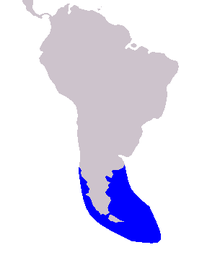Peale's dolphin
| Peale's dolphin | |
|---|---|
 |
|
| Scientific classification | |
| Kingdom: | Animalia |
| Phylum: | Chordata |
| Clade: | Synapsida |
| Class: | Mammalia |
| Order: | Artiodactyla |
| Infraorder: | Cetacea |
| Family: | Delphinidae |
| Genus: | Lagenorhynchus |
| Species: | L. australis |
| Binomial name | |
|
Lagenorhynchus australis (Peale, 1848) |
|
 |
|
| Peale's dolphin range | |
Peale's dolphin (Lagenorhynchus australis) is a small dolphin found in the waters around Tierra del Fuego at the foot of South America. It is also commonly known as the black-chinned dolphin or even Peale's black-chinned dolphin. However, since Rice's work Peale's dolphin has been adopted as the standard common name.
Though it is traditionally placed in the genus Lagenorhynchus, recent molecular analyses indicate Peale's dolphin is actually more closely related to the dolphins of the genus Cephalorhynchus. If true, this would mean this species must either be transferred to Cephalorhynchus or be given a new genus of its own. An alternate genus proposed for this species (as well as the Pacific white-sided dolphin and dusky dolphin is Sagmatias. Some behavioral and morphological data support moving Peal's dolphin to Cephalorhynchus. According to Schevill & Watkins 1971, Peale's dolphin and the Cephalorhynchus species are the only dolphins that do not whistle. Peale's dolphin also shares with several Cephalorhynchus species the possession of a distinct white "armpit" marking behind the pectoral fin.
Peale's dolphin is of typical size in its family — about 1 m in length at birth and 2.1 m (6.9 ft) when fully mature. Its adult weight is about 115 kg. It has a dark-grey face and chin. The back is largely black with a single off-white stripe running curving and thickened as it runs down the back on each side. The belly is white. Conspicuously, also a white patch occurs under just behind each flippers. These are known as the "armpits". The flanks also have a large white-grey patch above the flipper. The dorsal fin is large for this size cetacean and distinctively falcated. The flippers themselves are small and pointed. The tail fin, too, has pointed tips, as well as a notch at its middle.
The species looks similar to the dusky dolphin when viewed at a distance, and may be confused with it.
Peale's dolphin is endemic to the coastal waters around southern South America. On the Pacific side, they have been seen as far north as Valdivia, Chile at 38°S. On the Atlantic side, sightings typically diminish at about 44°S — near Golfo San Jorge, Argentina. In the south, they have been seen at almost 60°S — well into the Drake Passage.
...
Wikipedia

